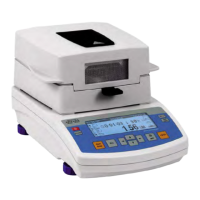Final measurement result is vastly conditioned by precise and considered
sample preparation. A sample used for analysis has to represent the total structure
of tested material. Sampling process should determine: sampling means, sample
disintegrating, particle size after disintegration, sample uniformity and other. The
sampling process should be carried out as quickly as possible, so that a sample
does not loose or absorb humidity from surrounding area.
Applied sampling standards should match individual user needs and
requirements of tested material, its consistence and sample size.
Number of samples
Increasing number of tested samples also increases statistic measurement
certainty. Number of samples depends on uniformity of tested material , its purity,
accuracy of applied measuring method and anticipated accuracy of obtained
results.
Material mechanical disintegrating for measurements
Applied disintegrating method should be selected appropriately to tested
material. Substances that are hard and brittle (crisp) can be disintegrated by cutting.
Grinding such substances may cause their heating and thus humidity vaporization,
resulting in unreliable measurement results. Unless a substance can be prepared
for measurement otherwise than grinding, any possible moisture content loss
should be calculated.
Use of high-silica sand
Ensuring optimum substance drying requires that a sample has the largest
possible surface for moisture content vaporization. Test results of moisture content
in substance which surface has a form of a shell (e.g. glucose syrup) or doughy
(e.g. butter), can be much more reliable if a sample is mixed with a dried high-silica
sand (improvement of measurement accuracy and repeatability).
When testing a substance by mixing it with high-silica sand it is recommended
to use a disposable drying pan with higher edges due to larger volume of a sample
to be tested).
Grease in a form of paste or melting substances
Such substance requires testing with use of a filter made of glass fiber, which
considerably increases active evaporation surface by separating the substance
between the fiber. Initial filter drying is necessary only in case of measurements
which require very high accuracy.

